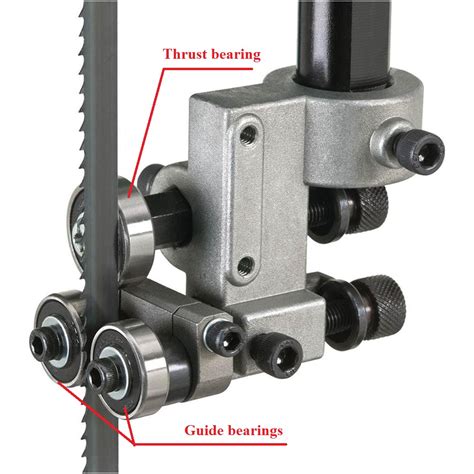Essential Guide to Bandsaw Guide Bearings: Enhancing Precision and Extending Blade Life
Bandsaw guide bearings play a critical role in maintaining blade stability, accuracy, and longevity. These bearings guide the blade smoothly along its path, reducing friction and preventing premature wear. By understanding the different types of guide bearings, their functions, and proper maintenance practices, you can optimize your bandsaw's performance and achieve exceptional results.
Types of Bandsaw Guide Bearings
There are primarily two main types of bandsaw guide bearings: ball bearings and roller bearings.
Ball Bearings
- Characterized by their spherical balls that rotate within a raceway.
- Offer low friction and high speed capability.
- Suitable for lighter workloads and require less maintenance.
Roller Bearings
- Cylindrical rollers run on a raceway, providing more surface contact.
- Can withstand heavier loads and have a longer service life.
- May introduce slightly more friction than ball bearings.
Functions of Bandsaw Guide Bearings
Guide bearings perform several essential functions:

-
Stabilize the Blade: Ensure straight and true cuts by preventing blade deflection.
-
Reduce Friction: Minimize wear on the blade and bearings, extending their longevity.
-
Prevent Run-Out: Eliminate excessive wobble or vibration, ensuring precise cuts.
-
Adjust Cutting Angle: Allow for accurate angle cuts by adjusting the bearing position.
Proper Maintenance of Bandsaw Guide Bearings
Regular maintenance is crucial to ensure optimal performance and longevity of guide bearings:
-
Clean Regularly: Remove sawdust and debris with a brush or compressed air.
-
Lubricate: Use a light oil or grease specifically designed for bearings (every 50-100 hours of use).
-
Inspect Regularly: Check for any signs of wear, damage, or misalignment.
-
Replace as Needed: Replace bearings if they show excessive wear or failure.
Choosing the Right Guide Bearings
Selecting the appropriate guide bearings depends on factors such as:

-
Blade Type: Wider blades require larger bearings with higher load capacity.
-
Material Thickness: Thicker materials necessitate more robust bearings.
-
Workload: Bearings designed for heavier loads will provide longer service life.
Strategies for Optimizing Guide Bearing Performance
- Use high-quality bearings from reputable manufacturers.
- Ensure proper alignment and tension of the blade.
- Clean and lubricate bearings regularly according to the manufacturer's recommendations.
- Use a bearing protector to shield bearings from sawdust and debris.
- Store the bandsaw in a clean and dry environment when not in use.
Tips and Tricks
-
Use a bearing puller: For safe and effective removal of old bearings.
-
Measure the bearings accurately: Avoid using bearings that are too large or small.
-
Apply lubrication sparingly: Excess lubrication can attract debris.
-
Check for play: Ensure there is no excessive play between the bearings and the shaft.
Pros and Cons of Different Guide Bearing Types
| Bearing Type |
Pros |
Cons |
| Ball Bearings |
Less friction, cheaper, easier to maintain |
Lower load capacity |
| Roller Bearings |
Higher load capacity, longer service life |
More friction, more expensive, require more maintenance |
FAQs
-
What is the lifespan of bandsaw guide bearings? It varies depending on usage and maintenance, but typically ranges from 200 to 500 hours.
-
How often should I lubricate guide bearings? Lubricate every 50-100 hours of use.
-
Can I use regular oil or grease to lubricate guide bearings? Use only bearing-specific oil or grease.
-
Why are my guide bearings failing prematurely? This could be due to improper lubrication, excessive load, or misalignment.
-
How do I align the guide bearings? Use a machinist's level or a straight edge to ensure the bearings are parallel to the blade.
-
What are the signs of worn guide bearings? Loose or noisy bearings, excessive vibration, and poor blade tracking.
Call to Action
Ensure optimal bandsaw performance and extend blade life by properly maintaining guide bearings. Clean, lubricate, and inspect bearings regularly, and replace them when necessary. Implement the strategies outlined in this guide to maximize precision, productivity, and safety in your woodworking projects.

